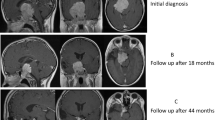Abstract
A 68-year-old manw as diagnosed as having left primary breast cancer. Systemic bone roentgenography showed no evident metastasis, however, skull roentgenography revealed ballooning of the sella turcica, suggesting a pituitary tumor, which was subsequently confirmed by computed tumography. Because there was a high serum prolactin level, the pituitary tumor was diagnosed as a prolactinoma. A modified radical mastectomy was performed for the breast cancer, and bromocriptine therapy given for the prolactinoma. Prolactin is known to initiate and promote breast cancer in mice and rats but little is known about its role in human breast cancer. If hyperprolactinemia plays an important role in the tumorigenesis of human breast cancer as it does in mice and rats, the incidence of breast cancer in patients with hyperprolactinemia may be high. To our knowledge, however, only four such cases have been reported. The present rare case of male breast cancer with prolactinoma is discussed with reference to the literature.
Similar content being viewed by others
References
Welsch CW, Nagasawa H (1979) Prolactin and murine mammary tumorigenesis: A review. Cancer Res 37:963
Nagasawa H (1979) Prolactin and human breast cancer (review). Eur J Cancer 15:267–279
Rolandi E, Barreca T, Masturzo P, Polleri F, Indiveri F, Barabino A (1974) Plasma prolactin in breast cancer. Lancet 2:845–846
Dicky RP, Minton JP (1972) l-Dopa effect on prolactin, folliclestimulating hormone and luteinizing hormone in women with advanced breast cancer: A preliminary report. Amer J Obstet Gynecol 114:267–269
Henderson BE, Gerkins V, Rossario I (1975) Elevated serum levels of estrogen and prolactin in daughters of patients with breast cancer. New Engl J Med 293:790–795
Rose D, Poritt B (1981) Plasma prolactin levels in patients with breast cancer. Cancer 48:2687–2691
Kwa HG, Cleton F, deJong-Barker M, Bulbrook RD, Hayward JL, Wang DY (1976) Plasma prolactin and its relationship to risk factors in human breast cancer. Int J Cancer 17:441–447
Mittra I, Hayward J, McNeilly A (1974) Hypothalamic-pituitary-prolactin axis in breast cancer. Lancet 1:889–891
Wilson RG, Buchan R, Roberts M, Forrest APM, Boyns AR, Cole EN, Griffiths K (1974) Plasma prolactin and breast cancer. Cancer 33:1325–1327
Kwa H, Wang D (1977) An abnormal luteal-phase evening peak of plasma prolactin in women with a family history of breast cancer. Int J Cancer 20:12–24
Olsson H, Alm P, Kristoffersson U, Landin-Olsson M (1984) Hypophyseal tumor and gynecomastia preceding bilateral breast cancer development in a man. Cancer 53:1974–1977
Theodorakis SP, Tedesco VE, Sutherland CM (1985) Breast cancer in a patient with prolactinoma. Surgery 98:367–369
Buytaert P, Viaene P (1981) Amenorrhea, galactorrhea, hyperprolactinemia syndrome and breast carcinoma in a young woman. Eur J Gynecol Reprod Biol 11:341–346
Daniels GH, Kourides IA, Maloof F (1976) Breast cancer in the Forbes-Albright syndrome. Acta Endocrinol 82:746–752
Loeb L, Kirtz MM (1939) The effects of transplants of anterior lobe of the hypophysis on the growth of the mammary gland and on the development of mammary gland carcinoma in various strains of mice. Am J Cancer 35:55–82
Muhlbock O, Boot LM (1959) Induction of mammary cancer in mice without the mammary tumor agent by isografts of hypophysis. Cancer Res 19:402–412
Boot LM, Muhlbock O, Ropcke G (1962) Prolactin and the induction of mammary tumors in mice. Gen Comp Endocrinol 2:601–603
Lacasagne A, Duplan JF (1959) Le Mécanisme de la cancérisation de la mamelle chez la souris. Considéré d'apres le résultats d'exeriences au mojen de la réserpine. Compt Rend 249:810–812
Meites J (1981) Relation of prolactin to development of spontaneous mammary and pituitary tumors. Prof Clin Biol Res 75B:1–8
Yanai R, Nagasawa H (1972) Inhibition of mammary tumorigenesis by ergot alkaloids and promotion of mammary tumorigenesis by pituitary isografts in adreno-ovariectomized mice. J Natl Cancer Inst 48:715–719
Yanai R, Nagasawa H (1970) Suppression of mammary hyperplastic nodule formation and pituitary prolactin secretion in mice induced by ergocornine or 2-bromo-α-ergocryptine. J Natl Cancer Inst 45:1105–1112
Dux A, Muhlbock O (1969) Enhancement hypophyseal hormones on the malignant transformation of transplanted hyperplastic nodules of the mouse mammary gland. Eur J Cancer 5:191–194
Quadri SK, Meites J (1971) Regression of spontaneous mammary tumors in rats by ergot drugs. Pros Soc Exp Biol Med 138:999–1001
Ohgo S, Kato Y, Chihara K, Imura H (1976) Plasma prolactin responses to thyrotropin-releasing hormone in patients with breast cancer. Cancer 37:1412–1416
Dao TL (1972) Ablation therapy for hormone-dependent tumors. Annu Rev Med 23:1–18
Editorial (1972) Prolactin and Breast Cancer. Lancet II, pp 1129–1130
Jensen HM, Rice JR, Wellings SR (1976) Preneoplastic lesions in the human breast. Science 191:295–297
Beeby DI, Easty GC, Gazet JC, Grigor K, Neville AM (1975) An assessment of the effects of hormones on short term organ cultures of human breast carcinoma. Br J Cancer 31:317–328
DeSouza I, Hobbs JR, Morgan L, Salih H (1977) Localization of prolactin in human breast tumors. J Endocrinol 73:17–18
Hobbs JR, Barrett A, DeSouza I, Morgan L, Raggatt P, Salih H (1975) Selection of anti-hormonal therapy of some cancers. In: host defense against cancer and its potentiation. Mizuno D, Chihara G, Fukuoka F, Yamamoto T, Yamamura Y (eds) University of Tokyo Press, Tokyo, pp 435–441
Morgan L, Laggatt PR, DeSouza I, Salih H, Hobbs JR (1977) Prolactin receptors in human breast tumors. J Endocrinol 73:17–17
Sato O, Daibo M, Tanabe S, Inoue Y, Tsuchiya H (1983) Prolactin-secreting pituitary adenomas in men: Comparison with female cases. Neurol Surg 11:279–287
Vorherr H (1980) Breast Cancer (Review). Urvan Schwartzenberg, Munich, pp 284–285
Author information
Authors and Affiliations
Rights and permissions
About this article
Cite this article
Haga, S., Watanabe, O., Shimizu, T. et al. Breast cancer in a male patient with prolactinoma. Surg Today 23, 251–255 (1993). https://doi.org/10.1007/BF00309236
Received:
Accepted:
Issue Date:
DOI: https://doi.org/10.1007/BF00309236




